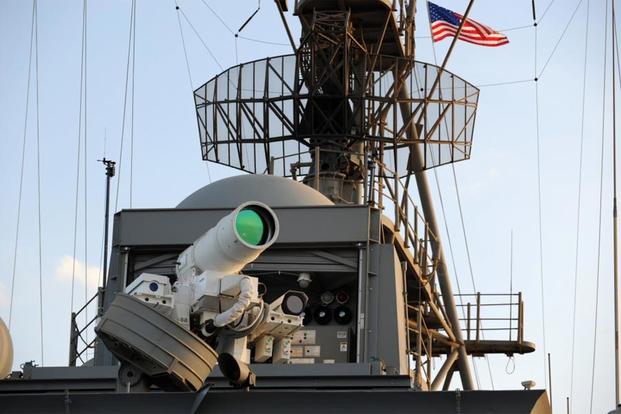QUANTICO, Virginia -- A Navy warship is getting a laser five times stronger than the one the service has tested in the past, and officials say it could lead the way for more vessels to head to sea with similar weapons.
The amphibious transport dock ship Portland is being outfitted with a 150-kilowatt laser system. That's a big power leap from the 30-kilowatt Laser Weapon System, or LaWS, that the service field-tested on the amphibious transport dock ship Ponce about five years ago.
"Big things" are expected from the Portland's new laser, Thomas Rivers, program manager for the amphibious warfare program office, said here at the Modern Day Marine 2019 expo.
"They're just putting it on the ship now," he said. "... And this may be the beginning of seeing a lot more lasers coming onto different ships."
Related: Check out Military.com's coverage of Modern Day Marine 2019
The laser will give the Portland the firepower to take out drones and small boats, Rivers said. It's also equipped with a camera that brings new intelligence, surveillance and reconnaissance capabilities, he added.
When the LaWS was tested in 2012, a Navy video showed how it could target small aircraft or boats without using bullets.
A video of a demonstration of the 30-kilowatt system being tested on the guided-missile destroyer Dewey showed the laser closing in on an unmanned aircraft off the coast of San Diego. That drone quickly caught fire and slammed into the ocean.
Sailors and Marines could find themselves needing to fight their way to shore in the Pacific and other theaters. Crews aboard amphibious ships that carry Marines could also need to fight as they sustain forces on the ground and as they head back out to sea, said Frank DiGiovanni, deputy director of expeditionary warfare.
That's what has some Navy officials talking about arming amphibious ships with offensive capabilities, Rivers said. Typically, the focus has been on defensive capabilities and survivability.
But looking at ways to arm them in the future "is not off the table," he added.
-- Gina Harkins can be reached at gina.harkins@military.com. Follow her on Twitter @ginaaharkins.
Read more: Marines Test Nonlethal Mortar Round for Crowd Control













